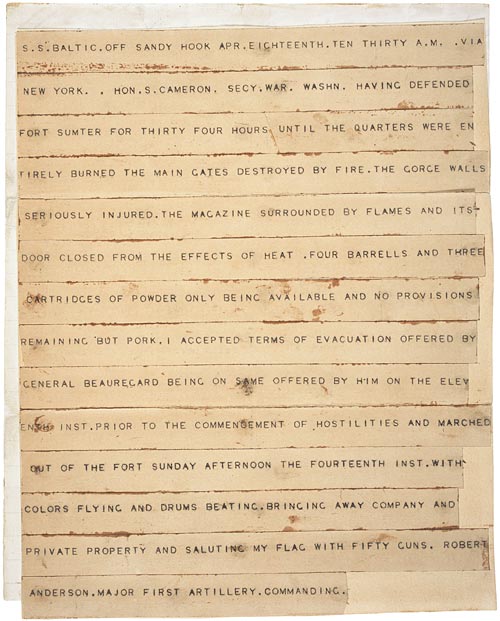
Telegram Announcing the Surrender of Fort Sumter (1861)
The first engagement of the Civil War took place at Fort Sumter on April 12 and 13, 1861. After 34 hours of fighting, the Union surrendered the fort to the Confederates.
When Abraham Lincoln took office, the nation was breaking apart. South Carolina, Mississippi, Florida, Alabama, Georgia, Louisiana, and Texas had already seceded. In his inaugural address on March 4, 1861, President Abraham Lincoln asserted that secession was unconstitutional, that the Union of the states was perpetual, and states could not leave it at will.
As the first states seceded, they seized most forts, arsenals, and federal property inside their borders. On April 10, 1861, Brigadier General Pierre G.T. Beauregard, in command of the provisional Confederate forces at Charleston, South Carolina, demanded the surrender of the U.S. garrison of Fort Sumter in Charleston Harbor. Garrison commander Major Robert Anderson refused.
On April 12, the Confederate batteries opened fire on the fort, which was unable to reply effectively. At 2:30 p.m., April 13, Major Anderson surrendered Fort Sumter, evacuating the garrison on the following day. The battle had started at 4:30 a.m. and ended 34 hours later.
Major Anderson notified Secretary of War Simon Cameron of the outcome of the battle by telegram five days after he surrendered to Confederate Brigadier General Pierre G.T. Beauregard, as seen in this document.
The bombardment of Fort Sumter was the opening engagement of the American Civil War. From 1863 to 1865, the Confederates at Fort Sumter withstood a 22-month siege by Union forces. During this time, most of the fort was reduced to brick rubble.

